“Firebird” by Konstantin Kalinin
He never walked along the beaten paths — mostly unusual machines that contained original solutions came out of his design bureau, and the development of new schemes included promising design and scientific techniques that were widely used only many years later ...
В Aviation K.A. Kalinin came in 1916, becoming a military pilot. The imperfection of the aircraft of that time was a motivation for the pilot to create aircraft of new schemes. However, he only had such an opportunity in 1925, when he began working as an aviation engineer at the Remvozdukhzavod in Kiev. Having headed the initiative group of aviation enthusiasts, which, in addition to himself, included D. L. Tomashevich, A. N. Graziansky and A. T. Rudenko, K. A. Kalinin created his first machine, which later became known as K-1.
The tests of this passenger elliptical wing monoplane were successful, the aircraft was found fit for work in the Civil Air navy, and the aircraft designer was proposed on the basis of K-1 to create several modifications of the airplane. K. A. Kalinin was to do this already in Kharkov, where he received an independent production base - the workshops of Ukrvozdukhput, later named GROS (Civil Experimental Aircraft Engineering). One of the modifications, which received the K-5 index, became perhaps the most popular passenger aircraft of the 30s. K-5 could carry 8 passengers at a distance of up to 800 km at a speed of 160 km / h.
In 1930, in KB K.A. Kalinanachali, the design of the giant K-7 aircraft with seven 750-powerful engines. It was a completely unusual two-beam bomber with a 38 T flight weight and a bomb load of up to 13 T. Unfortunately, its design was not strong enough and rigid, so the “seventh” did not go into the series. In addition, by the year 1933, when the machine entered the tests, the concept of the giant aircraft became more and more doubtful. High-speed aircraft with a high wing load, which had enhanced aerodynamic qualities, were already replacing the celestial slow-moving ships. It was in this direction that the search for a talented aircraft designer was going.
In February, 1989 marks 100 years since the birth of KA Kalinin. We celebrate this date with the story of the creation of the K-12 — one of the most extravagant aircraft of the designer. Machine drawings are published for the first time.
At the beginning of the 30-s, it became clear that one of the most popular and multi-purpose aircraft - the N.N. Polikarpov-designed P-5 no longer meets the increasing requirements for this type of aircraft. By February, 1931, the Air Force Research Institute developed tactical and technical requirements for the new aircraft, called the “military”. And 4 July 1932 of the Year, the Council of Labor and Defense commissioned the design and construction of such a machine to a team of Kharkiv Aviation Plant Experimental and Serial Aircraft Building (HAZOSS) headed by Director and Chief Designer K. A. Kalinin.
The first five-year plans for the Kalinin Design Bureau proved to be very successful. During this period, multi-purpose aircraft K-9 and K-10 were built and successfully flew. Completed manufacturing giant K-7. And, finally, a new task - a military aircraft BC-2 (indexing KB - K-12). It was assumed that the BC-2 will be able to stay in the front sky for a long time and perform the functions of a light bomber, troop reconnaissance, spotter, photographer, and, if necessary, transport and sanitary aircraft. The maximum speed of the car should have been 250 km / h at an altitude of 3000 m, the radius of action 350 km, the bomb load 300 kg.
In April, 1933 of Kharkov presented to the experts of the Scientific Research Institute of the Air Force preliminary draft designs of the future aircraft. And on their court three equivalent variants were taken out. The first was arranged according to the traditional scheme. The second was a double-frame frame aircraft with a tail machine-gun installation and a crew inside the wing. And finally, the third - tailless aircraft. The last option seemed to Kalinin the most interesting.
The specialists subjected the drawings and calculations to scrupulous verification. The project was also repeatedly discussed at meetings with the Chief of Staff of the Air Force V.K. Lavrov. The arguments of KA Kalinin turned out to be convincing enough to dwell on the “flying wing” scheme. It was really a bold step: the problem of creating tailless aircraft by that time was practically and theoretically not yet resolved. Both in our country and abroad, many designers were engaged in it, but it didn’t go further than the construction of tailless gliders and experimental machines.
Somewhat later, when K-12 was already flying, Konstantin Alekseevich described the possibilities of his brainchild as follows: “A plane without a tail, or else a tailless tail, has many advantages over an ordinary plane. When used militarily, it is especially valuable for its maneuverability and fire protection capability. ” Indeed, the absence of a tail empennage behind the wing made it possible to place behind the rear aft rifle tower for a full perimeter defense, which could not be done on aircraft of normal types. In addition, the machine of such a scheme had a smaller frontal resistance, and therefore a greater speed, range, and carrying capacity. With the power plants of the same power with the aircraft of the traditional scheme in the “flying wing” the weight is distributed over a larger area of the wing, and its design is much easier.
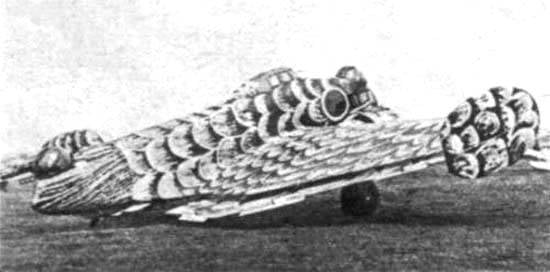
The work began with the purging of models in the KHAI wind tunnel, and taking into account the experiments of echih in September 1933, a second draft design appeared. The new version was different from the classic “flying wing”, in the documents of the design bureau it was called the “short tail”. The car looked quite unusual. Thus, a powerful flap was placed along the entire trailing edge of the wing, which made it possible to significantly reduce the landing speed. That is why the elevator and stabilizer were attached to the rear of the fuselage. The ailerons, called the “garden bench,” are on racks at the end of the wing. Controls of this type in combination with flaps were later successfully used on high-speed machines by the American designer D. Northrop.
For the “short tails” wing, a little-known NASA R-106R profile was chosen, and the wing itself was equipped with automatic and controlled slats on its leading edge.
The project provided for a civilian modification of the aircraft on 11 passengers with luggage.
The new project entailed new purges, and their results forced KA Kalinin to abandon the “short tail” scheme and return to the tailless aircraft. Accordingly, no slat, stabilizer and remote aileron were needed. To ensure longitudinal stability, the wing profiling was also changed: instead of NASA R-106R with aerodynamic wing twist, the TsAGI R-11 domestic profile was successfully used, successfully modified by the designers of the control group headed by A. V. Kovalenko. And along the entire trailing edge of the wing, an auxiliary plane was hung on the brackets, performing the role of horizontal tail. Interestingly, she had the same profile - TsAGI P-11, inverted by 180 ° with respect to the wing. An equally unexpected solution allowed achieving reliable longitudinal stability in all flight modes. A wing with a modified profile, in addition, had good load-bearing properties when landing, in contrast to the wings with a negative profile twist.
The functions of vertical tail assembly were elliptical washers located at the ends of the wing. The rudders diverted separately and only to the outside.
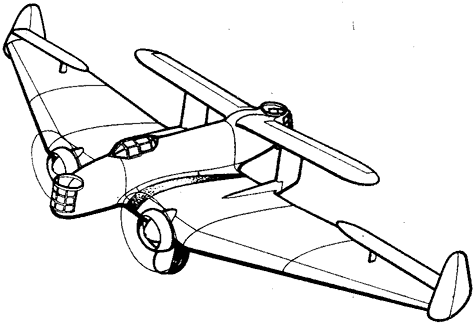
Sketch design of aircraft VS-2
To test his theoretical calculations, KA Kalinin decided to build another aerodynamic model, but not a purge, but ... a flying one. In essence, this was a real glider. They made it all-wood, on the scale of 1: 2 - in relation to the aircraft. Test pilot P.O. Borisov made over a hundred successful flights on it, investigating various modes in real conditions. This technique, by the way, has become widespread today. Suffice it to recall the passenger supersonic Tu-144 and its reduced copy - analogue aircraft.
In one of the first flights there was a case that confirmed the correctness of the chosen scheme. At a height of about three kilometers due to insufficient strength, the elevator rocking chair broke. The glider nodded sharply, entering a steep dive, the seatbelts did not withstand the overload, and the pilot was thrown out of the cockpit. Borisov safely landed on the ground with a parachute. But the glider also remained intact: it suddenly leveled off, began to smoothly descend in a spiral and made a normal landing.
The high longitudinal and traveling stability of the glider-analogue made it possible to make long-distance towing flights on it. It was also practically proved the possibility of performing horizontal flight on a tailless tail with an abandoned control stick. This experiment, brilliantly demonstrated by Borisov, practically proved the possibility of longitudinal aerodynamic balancing of machines of the chosen scheme. In general, the analog model has greatly accelerated and facilitated the design of the aircraft.
The tests of the airframe coincided with the move of the design bureau to Voronezh, where KA Kalinin was provided with a new production base at the aviation plant. The entire 1935 year is spent on placement at a new location, and only at the beginning of next year, the pilot workshop of the plant starts building a real aircraft.
The new machine has absorbed the results of numerous calculations, as well as aerodynamic and field experiments. The frame of the aircraft was welded from chromansile pipes, the skin was linen, and in the cockpit of the pilot and navigator - duralumin. The ribs and spars of the wing, as well as the ribs of the plumage were performed uniform, from pipes. For their calculation, an original method developed by engineer V.K. Zolotukhin was applied.
Each of the wing consoles was an integral welded unit composed of spars, ribs, edges and other nodes.
Large welded steel units and three fuselage compartments, bolted together. Steering surfaces and end washers are made of duralumin pipes covered with canvas.
Chassis - non-retractable, two-wheeled, balloon, with brakes. The tail wheel had oil-pneumatic damping.
In a rather spacious fuselage, the designers positioned the CD-2 cluster bomb rack, the stationary photo-installation AFA-13 and the coherent radio station VSK-2. In the nose and stern of the fuselage, the installation of ShKAS machine guns in the transparent rotating turrets was located. Bomb load was equal to 500 kg.
Two engines M-22 for 480 l. with. With two-bladed fixed-pitch propellers with a diameter of 2,8, they were covered with NASA hoods with flaps adjustable in flight.
The crew consisted of three people: a pilot, a navigator and a tail gunner. The control of the aircraft was double - in the cockpit was located the steering wheel, in the cockpit of the navigator - removable handle.
In July, the 1936 of the year K-12 was rolled out onto the airfield. Pilot-Tester P. O. Borisov took his place in the cockpit, closed the lamp lock. A short run - and K-12 soared into the sky ...
Assessing the results of the first flights, the press noted that “... the aircraft of the design of the t. Kalinin, despite its relatively large dimensions, has good take-off and landing characteristics. It is not very sensitive to the bumpiness and is very stable in flight. ”
In Voronezh, K-12 completed a factory test program from 46 flights, and in early October 1936 overtook it at the Air Force Institute, near Moscow, where state tests had already begun.
Of course, not all flights went smoothly. The behavior of the aircraft in the air, due to the innovations applied by KA Kalinin, turned out to be unusual for many pilots. The psychological barrier that couldn’t let go of the usual stereotypes of controlling conventional machines, even for such an experienced test pilot as P. I. Stefanovsky, became insurmountable. The pilot for a long time could not adapt to the original control of the aircraft, and this largely determined the further fate of the car.
The military pilots K-12 aroused great interest. During the tests, they made comments and suggestions on which KA Kalinin and his small group promptly made improvements and changes in the design of the aircraft.
18 August 1937 year K-12 first shown on the air parade in Tushin. It looked very unusual, on the orders of the head of the Air Force Scientific Research Institute, P.I. Baranov, the plane was painted under the fabulous “Firebird”. The appearance in the sky of such an unusual machine made a great impression on the members of the government and the command of the Red Army present at the celebration.
During the tests, which lasted the entire 1937 year, it was proved that the aircraft tailless system has good stability and controllability and can confidently fly, and its take-off and landing characteristics allow the machine to be operated at almost any airfield.
At the same time, it became clear that not all of the problems that were standing were resolved. K-12 had unsatisfactory travel stability, a strong dive moment, the efficiency of the end washers was insufficient, Testers did not suit the planting facilities and the design of rifle towers.
According to the test results, the following conclusion was made: “The aircraft VS-2 is of undoubted interest, since its construction was the first to resolve the issue of creating a“ flying wing ”in the armed version.” None of the tailless ones received such high marks on the trials. Thus, KA Kalinin and the staff of his design bureau won a convincing victory.
12 December 1937, Assistant Chief of the Air Force Ya. V. Smushkevich signed an official decision on the test report of the K-12 aircraft, which stated:
“To note that the aircraft VS-2 in its concept is of great interest to the Air Force ... Provide fine-tuning of the aircraft VS-2 to 1 March 1938, then present it for testing ...”
At the end of 1937, Konstantin Alekseevich was given one of the aircraft factories for further development of K-12. Within two months, the machine was equipped with more powerful M-25 engines with propellers of variable pitch, retractable electric chassis and slightly modified armament.
In this form, K-12 has already been recommended for mass production. At the same time, the design of the new aircraft began to be worked out - KA Kalinin proposed to install vertical plumage in the jet of propellers, removing the washers from the ends of the wing.
After a short but intense test, K-12 was approved by the state commission, and in April 1938 of the year an act was launched on the deployment of mass production of the aircraft. However, the designer was not destined to see his “firebird” in the series. Shortly after his arrest, K.A. Kalinin died in a prison in Voronezh. For a while, a small series of ten K-12 was still being built, but soon by the order of the People's Commissar of the defense industry all work was stopped ...
В history Aviation aircraft K-12 (BC-2) entered as the world's first real bomber tailless scheme that meets all the requirements of the military tactics of its time. In 1958, the English magazine Air Pictorial posted a photograph of the K-12 with an eloquent signature: “This machine was the prototype of all modern supersonic aircraft.”
Aircraft K-12: 1 - weight balance, 2 - aileron, 3 - elevator, 4 - annular tubular oil radiator, 5 - propeller, b - ShKAS machine gun, 7 — sight, 8 — control handle of an aircraft, XNXX — XKXXXXXXXXX —Wheel 9X10, 1100 - bombshell compartment casements, 475 —cap hnNXX11, 12 — FAB-300 bombs, 150 - bomber CD-13, 50 — handlebar, 14 - throttle-hpn, nnXXX2-15-16 — 17; 18 - navigator's hatch, 19 - navigator's seat, 20 - elevator trimmer, 21 - M-22 engine, 23 - Venturi tube, 22 - engine mount, 24 - rear suspension first hand, 25 - oil tank, 26 - the docking station and the center-console, 27 - Flettner ailerons, 28 - rudder, 29 - rear gunner hatch, 30 - trim steering, 31 door pilot. 32 - carburetor air intake, 33 trim-canvas, 34 — trim-metal, 35 — PVD tube.
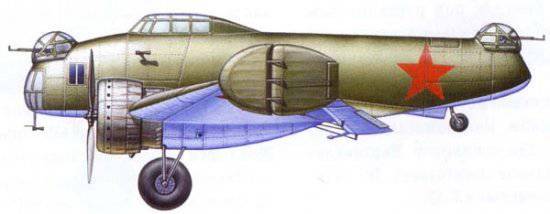

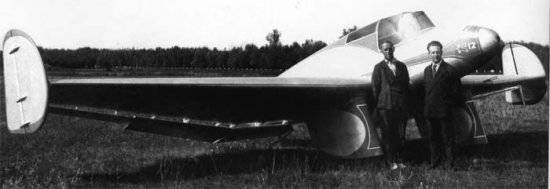
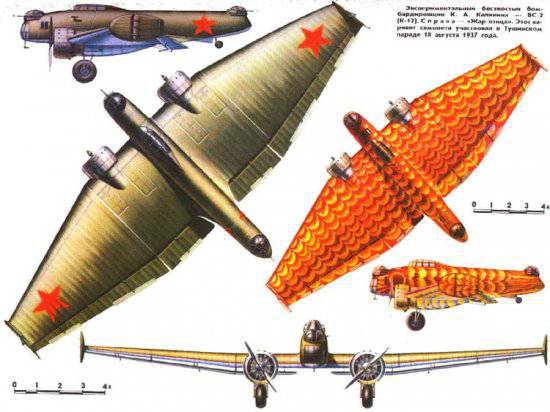
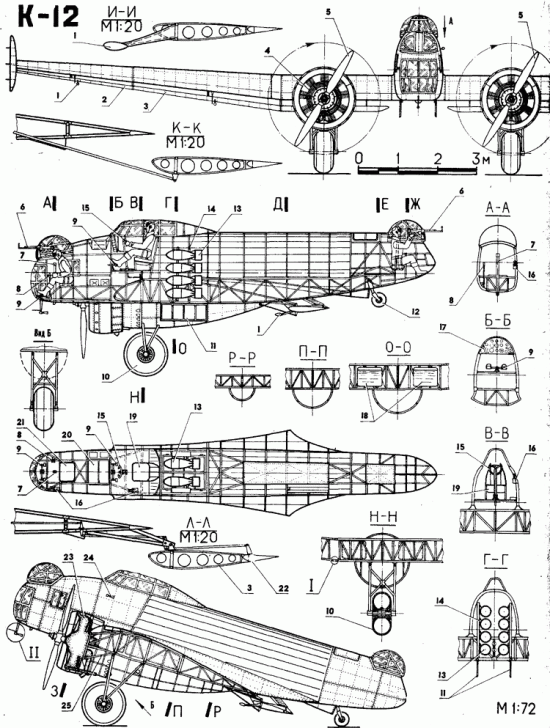
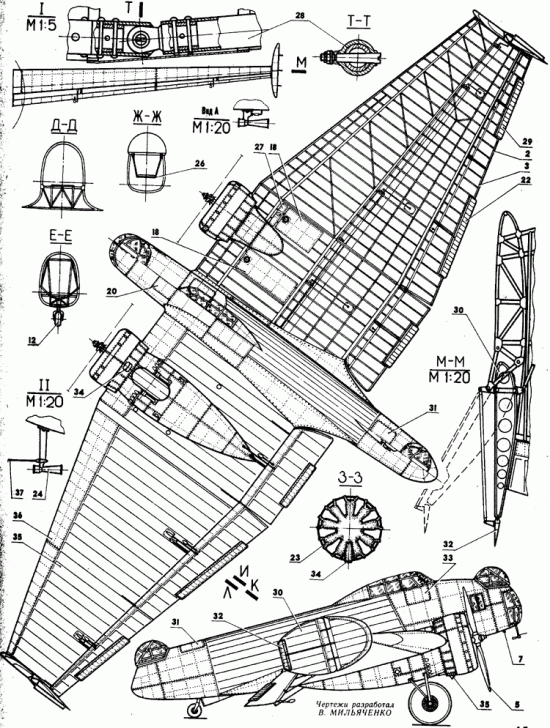
Information